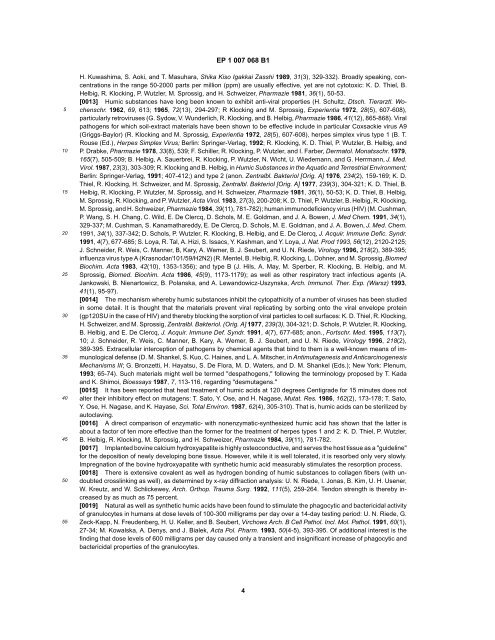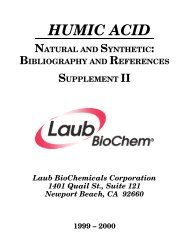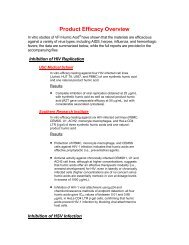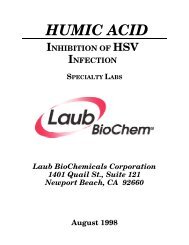HUMIC ACID - Laub BioChem
HUMIC ACID - Laub BioChem
HUMIC ACID - Laub BioChem
- No tags were found...
Create successful ePaper yourself
Turn your PDF publications into a flip-book with our unique Google optimized e-Paper software.
EP 1 007 068 B1510152025303540455055H. Kuwashima, S. Aoki, and T. Masuhara, Shika Kiso Igakkai Zasshi 1989, 31(3), 329-332). Broadly speaking, concentrationsin the range 50-2000 parts per million (ppm) are usually effective, yet are not cytotoxic: K. D. Thiel, B.Helbig, R. Klocking, P. Wutzler, M. Sprossig, and H. Schweizer, Pharmazie 1981, 36(1), 50-53.[0013] Humic substances have long been known to exhibit anti-viral properties (H. Schultz, Dtsch. Tierarztl. Wochenschr.1962, 69, 613; 1965, 72(13), 294-297; R Klocking and M. Sprossig, Experientia 1972, 28(5), 607-608),particularly retroviruses (G. Sydow, V. Wunderlich, R. Klocking, and B. Helbig, Pharmazie 1986, 41(12), 865-868). Viralpathogens for which soil-extract materials have been shown to be effective include in particular Coxsackie virus A9(Griggs-Baylor) (R. Klocking and M. Sprossig, Experientia 1972, 28(5), 607-608), herpes simplex virus type 1 (B. T.Rouse (Ed.), Herpes Simplex Virus; Berlin: Springer-Verlag, 1992; R.Klocking, K. D. Thiel, P. Wutzler, B. Helbig, andP. Drabke, Pharmazie 1978, 33(8), 539; F. Schiller, R. Klocking, P. Wutzler, and I. Farber, Dermatol. Monatsschr. 1979,165(7), 505-509; B. Helbig, A. Sauerbrei, R. Klocking, P. Wutzler, N. Wicht, U. Wiedemann, and G. Herrmann, J. Med.Virol. 1987, 23(3), 303-309; R. Klocking and B. Helbig, in Humic Substances in the Aquatic and Terrestrial Environment;Berlin: Springer-Verlag, 1991; 407-412;) and type 2 (anon. Zentralbl. Bakteriol [Orig. A] 1976, 234(2), 159-169; K. D.Thiel, R. Klocking, H. Schweizer, and M. Sprossig, Zentralbl. Bakteriol [Orig. A] 1977, 239(3), 304-321; K. D. Thiel, B.Helbig, R. Klocking, P. Wutzler, M. Sprossig, and H. Schweizer, Pharmazie 1981, 36(1), 50-53; K. D. Thiel, B. Helbig,M. Sprossig, R. Klocking, and P. Wutzler, Acta Virol. 1983, 27(3), 200-208; K. D. Thiel, P. Wutzler, B. Helbig, R. Klocking,M. Sprossig, and H. Schweizer, Pharmazie 1984, 39(11), 781-782); human immunodeficiency virus (HIV) (M. Cushman,P. Wang, S. H. Chang, C. Wild, E. De Clercq, D. Schols, M. E. Goldman, and J. A. Bowen, J. Med Chem. 1991, 34(1),329-337; M. Cushman, S. Kanamathareddy, E. De Clercq, D. Schols, M. E. Goldman, and J. A. Bowen, J. Med. Chem.1991, 34(1), 337-342; D. Schols, P. Wutzler, R. Klocking, B. Helbig, and E. De Clercq, J. Acquir. Immune Defic. Syndr.1991, 4(7), 677-685; S. Loya, R. Tal, A. Hizi, S. Issacs, Y. Kashman, and Y. Loya, J. Nat. Prod 1993, 56(12), 2120-2125;J. Schneider, R. Weis, C. Manner, B, Kary, A. Wemer, B. J. Seubert, and U. N. Riede, Virology 1996, 218(2), 389-395;influenza virus type A (Krasnodar/101/59/H2N2) (R. Mentel, B. Helbig, R. Klocking, L. Dohner, and M. Sprossig, BiomedBiochim. Acta 1983, 42(10), 1353-1356); and type B (J. Hils, A. May, M. Sperber, R. Klocking, B. Helbig, and M.Sprossig, Biomed. Biochim. Acta 1986, 45(9), 1173-1179); as well as other respiratory tract infectious agents (A.Jankowski, B. Nienartowicz, B. Polanska, and A. Lewandowicz-Uszynska, Arch. Immunol. Ther. Exp. (Warsz) 1993,41(1), 95-97).[0014] The mechanism whereby humic substances inhibit the cytopathicity of a number of viruses has been studiedin some detail. It is thought that the materials prevent viral replicating by sorbing onto the viral envelope protein(gp120SU in the case of HIV) and thereby blocking the sorption of viral particles to cell surfaces: K. D. Thiel, R. Klocking,H. Schweizer, and M. Sprossig, Zentralbl. Bakteriol. (Orig. A] 1977, 239(3), 304-321; D. Schols, P. Wutzler, R. Klocking,B. Helbig, and E. De Clercq, J. Acquir. Immune Def. Syndr. 1991, 4(7), 677-685; anon., Fortschr. Med. 1995, 113(7),10; J. Schneider, R. Weis, C. Manner, B. Kary, A. Wemer, B. J. Seubert, and U. N. Riede, Virology 1996, 218(2),389-395. Extracellular interception of pathogens by chemical agents that bind to them is a well-known means of immunologicaldefense (D. M. Shankel, S. Kuo, C. Haines, and L. A. Mitscher, in Antimutagenesis and AnticarcinogenesisMechanisms III; G.Bronzetti, H. Hayatsu, S. De Flora, M. D. Waters, and D. M. Shankel (Eds.); New York: Plenum,1993; 65-74). Such materials might well be termed "despathogens," following the terminology proposed by T. Kadaand K. Shimoi, Bioessays 1987, 7, 113-116, regarding "desmutagens."[0015] It has been reported that heat treatment of humic acids at 120 degrees Centigrade for 15 minutes does notalter their inhibitory effect on mutagens: T. Sato, Y. Ose, and H. Nagase, Mutat. Res. 1986, 162(2), 173-178; T. Sato,Y. Ose, H. Nagase, and K. Hayase, Sci. Total Environ. 1987, 62(4), 305-310). That is, humic acids can be sterilized byautoclaving.[0016] A direct comparison of enzymatic- with nonenzymatic-synthesized humic acid has shown that the latter isabout a factor of ten more effective than the former for the treatment of herpes types 1 and 2: K. D. Thiel, P. Wutzler,B. Helbig, R. Klocking, M. Sprossig, and H. Schweizer, Pharmazie 1984, 39(11), 781-782.[0017] Implanted bovine calcium hydroxyapatite is highly osteoconductive, and serves the host tissue as a "guideline"for the deposition of newly developing bone tissue. However, while it is well tolerated, it is resorbed only very slowly.Impregnation of the bovine hydroxyapatite with synthetic humic acid measurably stimulates the resorption process.[0018] There is extensive covalent as well as hydrogen bonding of humic substances to collagen fibers (with undoubtedcrosslinking as well), as determined by x-ray diffraction analysis: U. N. Riede, I. Jonas, B. Kim, U. H. Usener,W. Kreutz, and W. Schlickewey, Arch. Orthop. Trauma Surg. 1992, 111(5), 259-264. Tendon strength is thereby increasedby as much as 75 percent.[0019] Natural as well as synthetic humic acids have been found to stimulate the phagocytic and bactericidal activityof granulocytes in humans at dose levels of 100-300 milligrams per day over a 14-day testing period: U. N. Riede, G.Zeck-Kapp, N. Freudenberg, H. U. Keller, and B. Seubert, Virchows Arch. B Cell Pathol. Incl. Mol. Pathol. 1991, 60(1),27-34; M. Kowalska, A. Denys, and J. Bialek, Acta Pol. Pharm. 1993, 50(4-5), 393-395. Of additional interest is thefinding that dose levels of 600 milligrams per day caused only a transient and insignificant increase of phagocytic andbactericidal properties of the granulocytes.4










